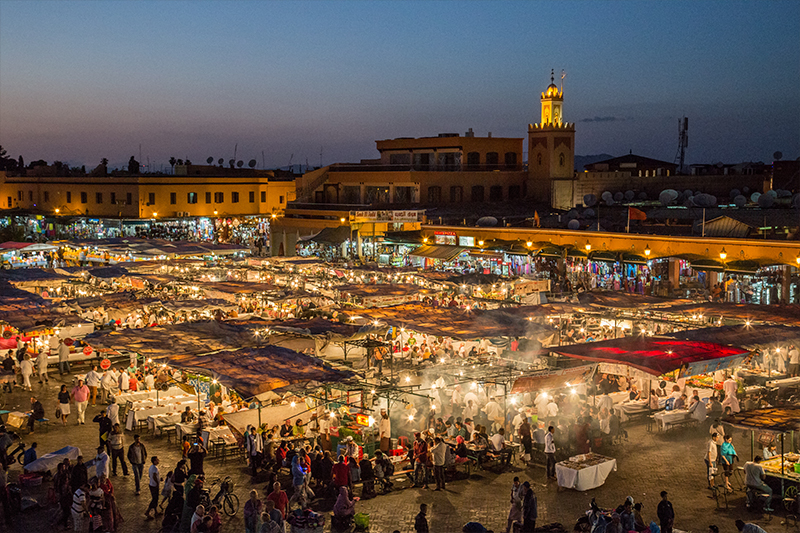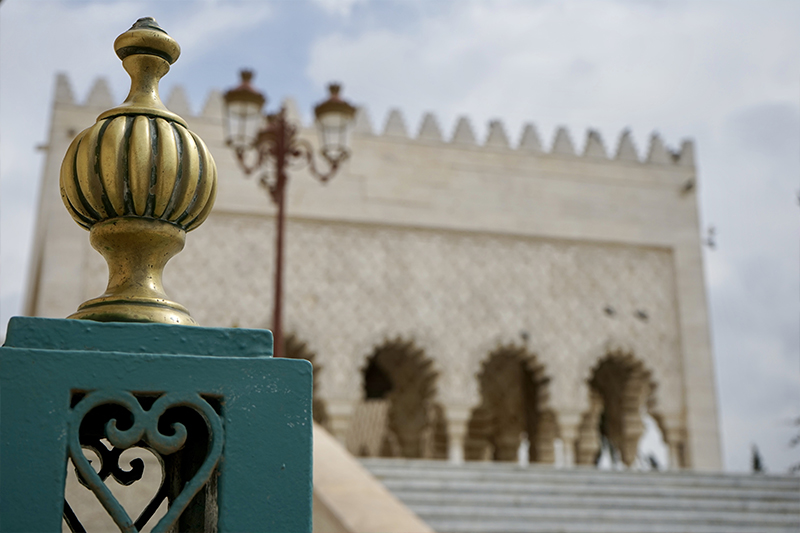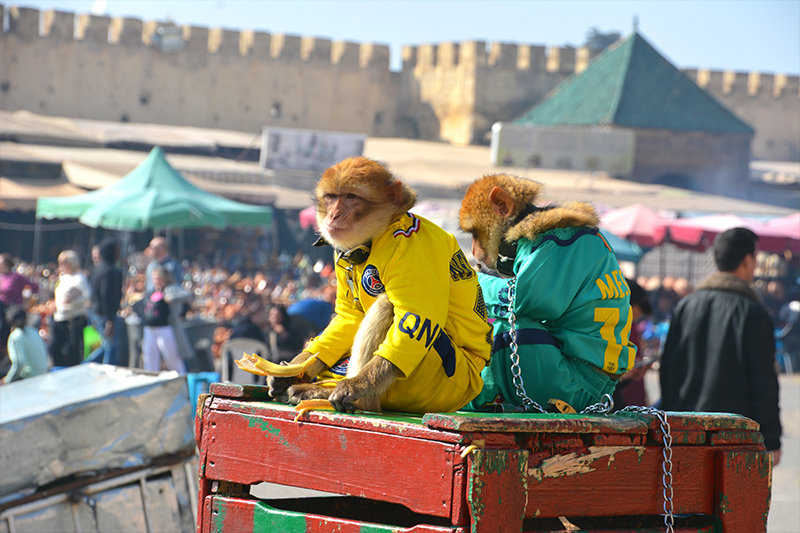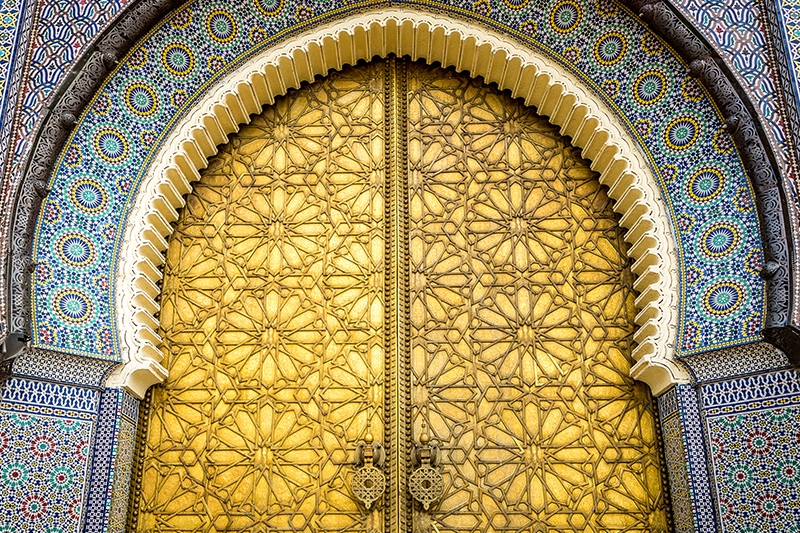Imperial Cities
If you are thinking about visiting Morocco, surely you have heard about its Imperial Cities, but not everyone knows what they are and why they are called that way.
Marrakech, Rabat, Fez and Meknes are the select group of the four imperial cities that were in the past and still are the cultural and political center of the country, and on some occasion were capitals of the Kingdom.
You may be surprised that Casablanca is not part of the list, but historically it didn’t have as much significance as the previous ones, although today it is the most modern and cosmopolitan city.

MARRAKECH
Marrakech is a vibrant city that attracts the traveler, and is an almost unmissable destination on your trip to Morocco.
In the middle of the medina, the heart of Marrakech, the life of the city flows through its intertwined streets, with the incessant comings and goings of its people.
Marrakech is one of those essential cities with imperial air, full of contrasts, aromas and colors.
Exotic, chaotic, mysterious and cosmopolitan, the city knows how to combine oriental fascination with western glamor.
At night, the mythical Plaza de Djemaa el Fna becomes the magical view that fascinates our visitors. The vitality that is breathed here is an indelible image, an experience full of surprises to observe in a continuous festive atmosphere.
All of it looks like a circus in which it is very difficult to walk without stopping at every step to watch a show: dancers, groups playing traditional music, street performers, storytellers, water boys, monkeys, women painting with henna, food stalls, juices, sweets, dates, figs, nuts, craft sales, games, snake charmers …
It’s a magical and festive atmosphere 365 days a year.
Since the sun begins to set and well into the night, the square is a full of people, offering their shows.
The whole square is surrounded by cafés-restaurants and terraces and from it start the streets that lead to the souks, the largest in the Maghreb.
Marrakech is in fashion. Many define it as a “chic” and “cool” city, and is becoming one of the celebrity favorite destinations.
RABAT

Rabat is the administrative and political capital of the Kingdom of Morocco.
The most suggestive part of Rabat is the Oudayas neighborhood, whose kasbha, surrounded by a sturdy wall and decorated with the pirate tower, attracts visitors with the romantic charm of its narrow streets and stairways.
The Hassan II Tower is the authentic and most famous monument and symbol of Rabat, the Imperial city and Capital of Morocco.
The forest of truncated columns is what remained of an unfinished mosque along with the Hassan Tower that should have been crowned as a minaret.
It was a project undertaken by Sultan Almohad Yacoub el-Mansour in the year 1197, which claimed that the Hassan Tower was the largest mosque in the entire Moroccan empire. The Hassan Tower was supposed to be about 80 meters high, but in the end it stood at the 44 meters, unfinished.
At the base of the tower, is the Mohamed V Mausoleum, other of the places you must-see if you are in Rabat, and one of the best examples of Islamic architecture.
The mausoleum, dedicated to the father of the penultimate sovereign, is made with Carrara marble and displays the traditional green roofs, in accordance with Islamic tradition.

MEKNES
Meknes, declared a World Heritage Site by Unesco in 1996, is famous for the beauty of its monumental gates, including Bab Mansour, Bab el Jemis, Bab Jamaa in Nouar and Bab el Jedid, while its souks are among the most important of Morocco.
The Bab Mansour gate, which is located between the two main squares of the city, is considered to be the most imposing gate in the entire Maghreb.
El Hedim Square is the center of political and social life, and the place where the heart of the city beats. Formerly it was a place of public executions and real announcements. Today, this wide square is full with restaurants and cafes, waterboys, snake charmers, street vendors in what reminds a lot the famous Djemaa el Fna Square in Marrakech.
The lively Plaza also serves as a separation between the Imperial City, which is accessed by the Bab Mansour Gate and the traditional Medina.
FEZ

Fez, the spiritual, religious and cultural capital of Morocco, and the oldest of the Imperial Cities, remains unchanged among the greenery of its valley.
Wrapped in walls, this ancient city likes to be seen by the newcomer.
To its river and to the 60 sources Fes owes its foundation in the year 788, when Emir Idriss I became fascinated by the beauty of the place. “Daughter of the water”, the city of the cedars grew for 1200 years becoming the spiritual and intellectual center of Morocco.
Fez keeps hidden behind its walls, its gardens, its mosques and palaces. An extraordinary universe that is accessed by its monumental doors.
Its walls hide the fabulous Royal Palace whose main door merges decorative elements of AlAndalus with other Moroccan’s elements, giving rise to a refined aesthetic of extraordinary beauty. Its door, with no doubt, is an announcement of interior luxury.
Opposite of the Royal Palace is the Jewish quarter (Mellah), also walled, whose houses with wooden balconies are unique in the medina. At each step you will notice the presence of the old offices of the Jewish community.
The oldest area of the medina is Fez El Bali, the largest urban complex in the world, without road traffic. When you walk slowly between streets full of vitality, you see craftsman selling their work where you will find the famous tannery Chouwara, the largest and well known of the four traditional tanneries that continue to work in the heart of the Medina of Fez.
Inside the medina you will discover with amazement a set of madrasas and mosques, where Allah is studied and thanked in each call to the Muecín prayer
The heritage of Fez is so rich, that UNESCO decided that its medina was worthy of entering the world heritage list in 1981.

CASABLANCA
Casablanca owes its name to the fact that, in the old days, the Portuguese sailors arriving to its port, recognized the place by the presence of a small white house located on the hills of Anfa, «the Casa (House) Branca (White)».
Casablanca enjoys an extensive coastline and a mild climate all year round.
At any time of day or night the city transmits a contagious energy of innovation in all areas: business, sports, culture, art, architecture …
The biggest international attraction of Casablanca is the new Hassan II mosque, with their colossal dimensions. Built on the shores of the ocean, the whole building occupies an area of 2 hectares and constitutes the first architectural testimony of contemporary Morocco.
It was designed by the French architect Michel Pinseau, the construction had begun on July 12, 1985 and was inaugurated on August 30, 1993.
Although its structure and decoration are traditional in style with wood and stucco carvings, polished marble, mosaics and granite, the mosque was equipped with the most sophisticated technology that allows, for example, to quickly open the roof, transforming the central nave in a huge courtyard.
The mosque can accommodate 25,000 faithfuls while more than 80,000 people fit in the outer esplanade. The minaret of the mosque with its 200m height is the largest in the world and its laser beam, which points to Mecca, can be seen from several kilometers.


